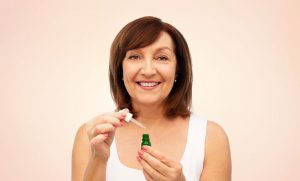Just when you thought you had your skin care routine down to a fine art, you hear about another step that you’re missing. Suddenly, everyone’s talking about ampoules… tiny little vials which contain powerful skin serums. So, ampoule vs serum, which is best?
Should I Use a Skin Serum or Ampoule?
In order to decide what’s best for you, let’s break down the differences and similarities between a skin serum and an ampoule.
Skin Serums
Skin serums contain concentrated, active ingredients designed to sink deep into your skin fast. They’re often gel-like in texture, and they target specific skin concerns. So, you may feel that you need an anti-aging serum, hydrating serum, or one that targets dark spots or fine lines.1
Because serums are so concentrated, you only need a few drops.
Serums offer many of the same skin care benefits as a Korean sheet mask. That’s why it’s recommended that you don’t wash your face after these masks, but instead smooth the residue into your skin for optimal hydration.
Ampoules
As it turns out, ampoules are a more concentrated version of a serum. They have a slightly thicker texture. Think of them as an advanced night repair system.
Do You Need Both an Ampoule and a Serum?
 You don’t need both an ampoule and a serum. You should just use one.
You don’t need both an ampoule and a serum. You should just use one.
Think of an ampoule as a short-term upgrade to your usual serum when your skin needs it the most. Perhaps you have a big event coming up, or maybe your skin is going through a rather bad, dry patch because of sudden changes in the weather? Using ampoules might prove beneficial.2
Ampoules contain a more active ingredient list than serums, but they’re intended to be used for a limited amount of time as a “booster.” Ampoules are tiny, separate capsules or vials, so that you use just the right amount.
How do Skin Types and Textures Determine Ampoules vs Serums?
Now, the most important factor when it comes to deciding whether to use a serum or an ampoule after cleansing is your skin concern. As long as it targets that skin issue, you’re good – no matter which one you use. For example, serums and ampoules might target:
- Dark Spots
- Breakouts
- Anti-aging concerns
- Sensitive skin issues
- Hydration for dry skin
You choose what you need most based on your skin concerns.

Both skin serums and ampoules usually contain active, natural ingredients. Their ingredients list may contain:
- Antioxidants
- Vitamins
- Botanical extracts
- Propolis – a restorative residue from honeybees
- Bifida ferment lysate – a hydrating type of fermented yeast
- Sodium hyaluronate / Hyaluronic acid – You may see these names thrown about interchangeably but they are slightly different. Sodium hyaluronate is the water soluble version of hyaluronic acid and is able to better penetrate more deeply into the skin for better hydration.3-5
Because ampoules are recommended for short-term use, consider using them either once a week for a boost, or as an intensive 3-day regime for emergency skin fixes.
Where do Ampoules Fit into a Beauty Routine?
A general rule of thumb for any product applied on the skin after cleansing and toning is “thinnest to thickest.” This ensures that everything is absorbed properly. This is because a product with a thinner consistency, like a serum, can’t penetrate through a thicker product (a moisturizing cream) to be effective.
Here’s a good skin care application system:
- Cleanser (or oil cleanser)
- Toner
- Serum or ampoule
- Eye cream
- Spot treatment
- Moisturizer
- Retinol (night only)
- Facial oils6
Though retinol and face oils are thinner than moisturizer, they work best following a moisturizer. For daytime, layer makeup or a BB cream last. And of course, make sure you’re wearing sunscreen!
A Quick Korean Skin Care Tip:
Make your own Korean sheet mask at home by soaking a few cotton pads in your favorite essence, emulsion, serum, or ampoule. Then, lay the pads on your face and relax for about 20 minutes for optimal hydration and repair.
Deeply Effective Skin Care
Both serums and ampoule beauty products contain ingredients that may help fight free radicals and the visible signs of aging for younger-looking skin. They may also help improve dry skin, dark spots, blemishes and much more – no matter your skin tone or type.
With so many skin care products to use after cleansing, it’s easy to feel overwhelmed. Just stick to the list above, and you’ll be well on your way to your best skin ever!
Learn More:
Exfoliation Secrets: AHA vs BHA — What’s the difference?
How to Get Healthy, Glowing Skin with Exercise
The Truth about Microneedling (Does it Really Work?)
Sources
1.https://www.allure.com/gallery/best-face-serum-by-skin-type
2.https://www.vogue.com/article/best-skincare-ampoules-serums-moisturizing-anti-aging-face-eyes-lips
3.https://www.ncbi.nlm.nih.gov/pmc/articles/PMC3583886/
4.https://www.ncbi.nlm.nih.gov/pmc/articles/PMC5549483/
5.https://www.ewg.org/skindeep/ingredient/700744/BIFIDA_FERMENT_LYSATE/
6.https://www.cosmopolitan.com/style-beauty/beauty/a25372431/what-order-to-apply-skincare-products/
























































